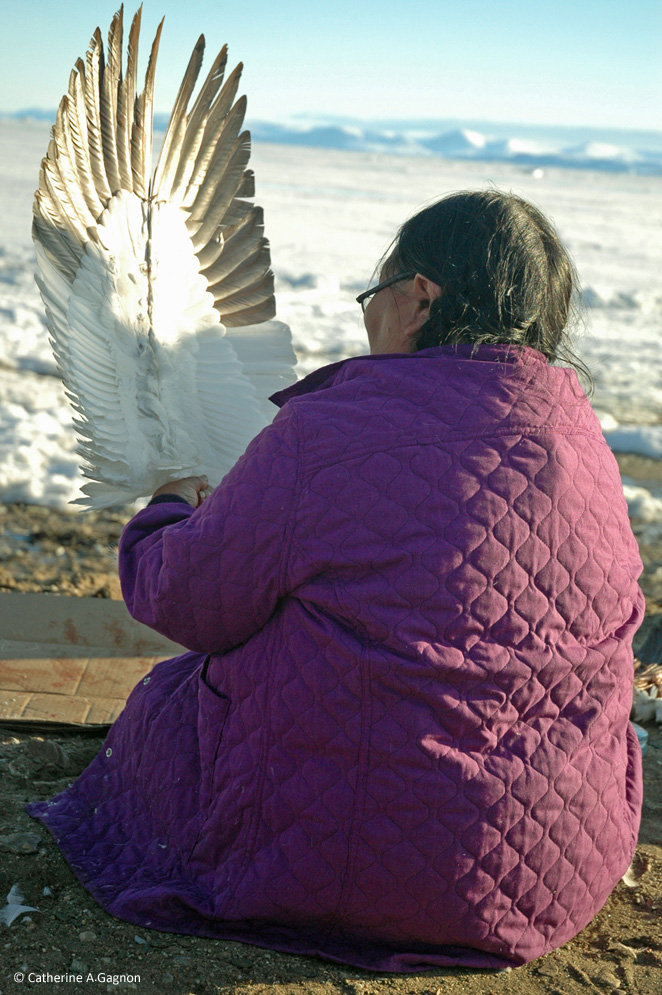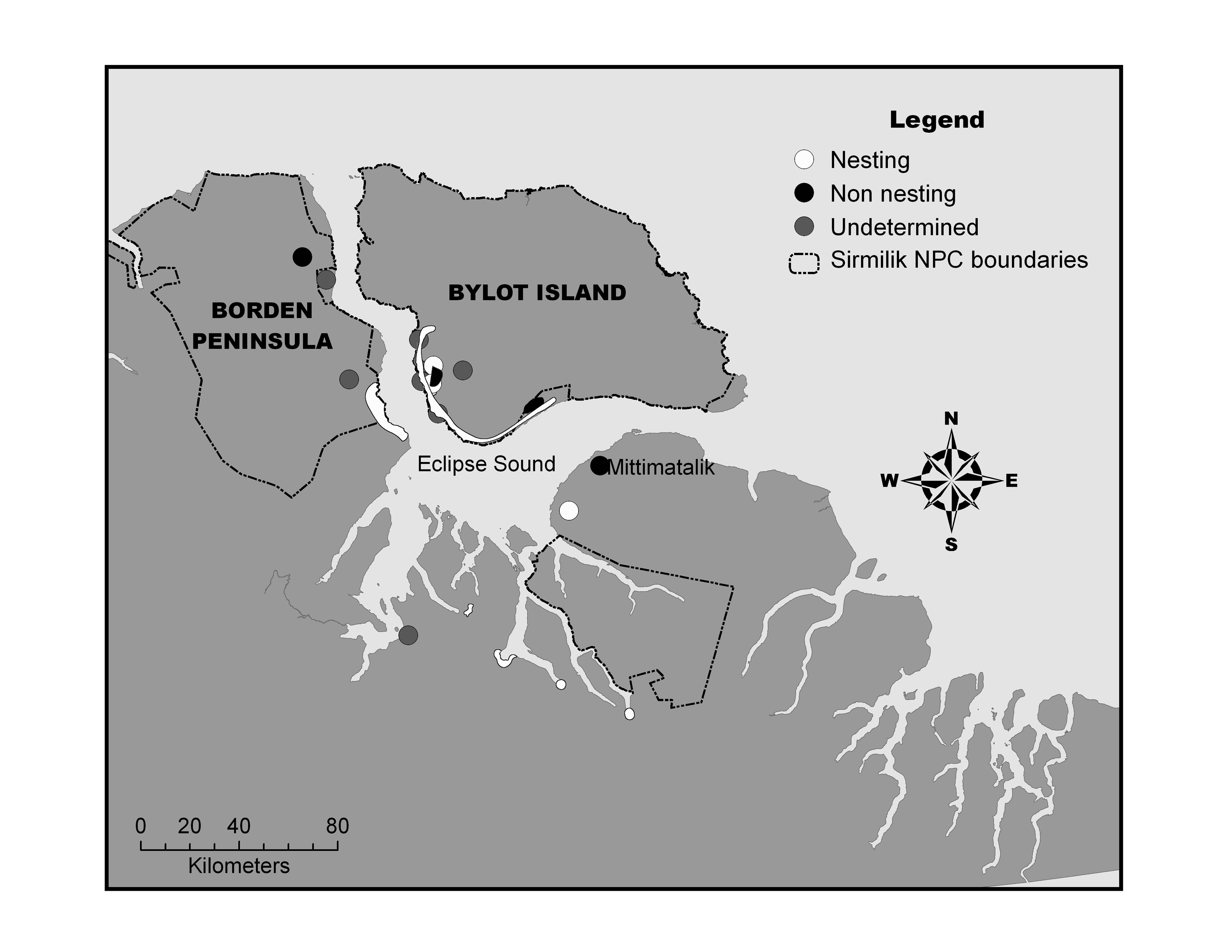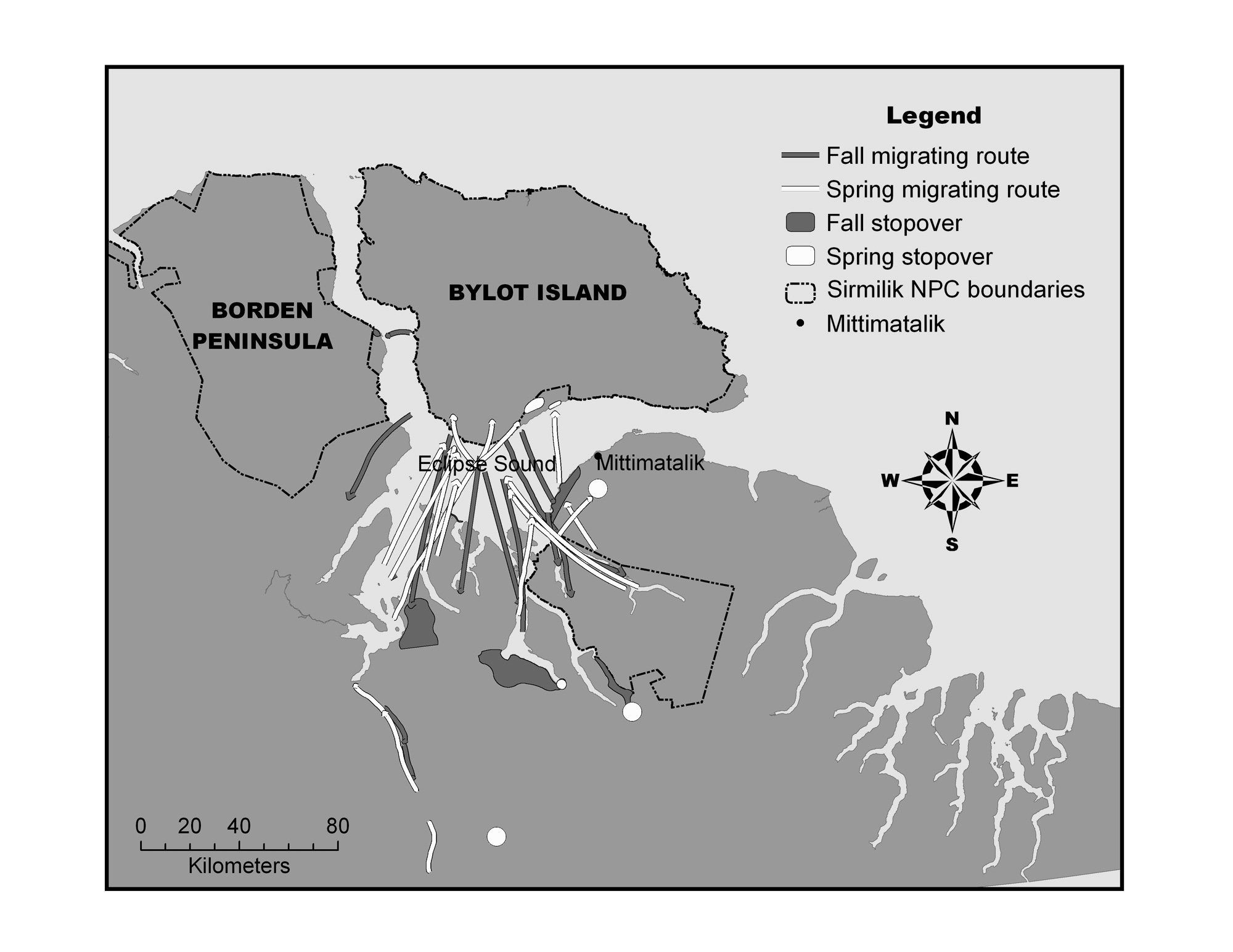Traditional uses and cultural importance
 | |
| Elder making a wall decoration out of goose wings |
Inuit families who have lived in the area of Pond Inlet have always considered goose meat and eggs as an alternate food source, both historically and up to the present. But the closer to the goose colony a person interviewed camped and hunted while younger, the more she/he seemed to consider goose meat and eggs as a delicacy.
Before the settlement (and the arrival of refrigeration), geese were mostly consumed immediately after being harvested. However, some families dried and cached goose meat to be consumed later. Traditionally, goose parts were also transformed for domestic uses. Wings were used as brooms, skin and feathers were sowed into mattresses, down was used to fill garments, and feet could be made into small bags. The trachea was even used by children to make flutes. Nowadays, some households still use goose wings as brooms or wall decorations and down is still being used to fill garments.
Because the goose arrival is a definite sign that spring has arrived and that the hardship of the winter season is over, geese have always had an intrinsic cultural value for Inuit families, associated to the feeling of hope that they brought along.
Ecology of greater snow geese
Molting cycle
People interviewed during the Inuit knowledge project were asked to comment on the timing when geese molt their feathers, as well as on the location where they go for molting. Fourteen interviewees commented. Of those, most said that non-nesting geese molt earlier than nesting ones.
When providing more specific information on the exact timing of the molt, six informants mentioned that non-nesting geese start their molt at the end of June, and another said they start to molt in mid-July. Nine out of fourteen interviewees more generally agreed that non-nesting geese molt through the month of July. Two informants interviewed in early August further commented that non-reproductive geese were just completing their molt at the moment, while nesting geese were in the midst of molting.
For nesting geese, ten interviewees commented that they molt when their goslings have hatched and have grown bigger. One informant mentioned that they start in the middle of July. Another interviewed in late July commented that nesting geese would molt later on, while another informant, also interviewed in late July, mentioned nesting geese were probably molting at that time.
Concerning molting locations for nesting and non-nesting geese, some interviewees indicated not knowing if non-nesting geese went to a particular place to molt, but others commented that nesting and non-nesting geese never molt together, while one person admitted not knowing if they stayed together. One informant also mentioned that nesting and non-nesting geese both molt on Bylot Island. Some elders and hunters also mentioned that nesting geese gather around ponds for molting and that non-nesting geese molt in higher grounds than nesting ones, although one hunter has seen nesting geese molting in more rugged terrain.
When asked if there have been any changes in the molting locations used by geese since they were younger, the general comment was that there has been no change or that the informant did not know if there has been a change.
Migration: timing of fall migration, routes and stopovers
When asked about goose migration, most persons interviewed provided comments. The majority of elders and hunters interviewed agreed that in the fall, geese leave the area of Pond Inlet from the end of August to the beginning of September, or as soon as they regain their flying capacities after molting.
Fifteen out of sixteen informants also commented that geese leave in small groups, but others believed they may gather in larger groups further south. Migrating routes have been noted on maps, which are similar for the spring and fall migrations, following a north-south axis from the south plain of Bylot Island to northern Baffin Island. Stopovers used by geese to rest and feed during migration have also been noted.
Trends in population numbers and distribution
When discussing the size of the overall goose population around Pond Inlet, answers were not unanimous among the thirteen elders and hunters who provided comments. Four out of them mentioned that the numbers did not change, two mentioned an overall increasing trend, two others mentioned a decline and five mentioned that they did not know or could not evaluate such trends. Four out of thirteen also mentioned that the population varies from year to year. However, a more unanimous comment was that geese are more scattered now than they used to be in the past and that geese are no longer concentrated on Bylot Island but have rather colonized other areas. One elder mentioned not having observed any changes in distribution.
When discussing the population on Bylot Island more specifically, eight out of fifteen interviewees mentioned having observed a decline in goose numbers in that area. To illustrate this, four stated that geese used to be all around the island. Six out of fifteen also mentioned that geese were so numerous in the past that they look like snow patches, something that is no longer observed on the island. Informants also commented that geese seem to have moved westward and on higher grounds of the island. In various locations, increasing and decreasing numbers have been noted.
According to a few persons interviewed, changes have been observed since biologists have started the goose surveys in the region. This corresponds to the early 1980s. Two informants out of ten noticed changes since the 1990s, two others in recent years, and one since the 1970s, when rifles and snowmobiles started to be used more widely. Finally, two out of ten interviewees noticed a change in goose abundance since their childhood (which occurred in the 1940s and the 1950s), the former mentioning an increase in abundance while the latter noticed a decline.
Biologists doing their research and their use of helicopters were the most often cited as the possible causes for those changes. Increased hunting pressure and the use of new hunting equipment such as rifles and snowmobiles were also mentioned as potential causes, along with an increase in aerial traffic around Pond Inlet and a potential increase in fox abundance since the collapse of the trapping economy.
When doing verification workshops to clarify information about changes in goose abundance, the consensus was that overall, geese may not be less, but are more dispersed than they used to be.
| Inuit knowledge on foxes |


